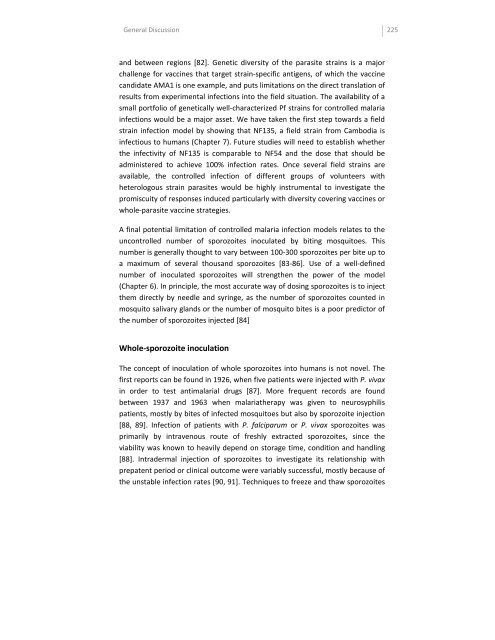Experimental infection and protection against ... - TI Pharma
Experimental infection and protection against ... - TI Pharma
Experimental infection and protection against ... - TI Pharma
You also want an ePaper? Increase the reach of your titles
YUMPU automatically turns print PDFs into web optimized ePapers that Google loves.
General Discussion 225<br />
<strong>and</strong> between regions [82]. Genetic diversity of the parasite strains is a major<br />
challenge for vaccines that target strain-specific antigens, of which the vaccine<br />
c<strong>and</strong>idate AMA1 is one example, <strong>and</strong> puts limitations on the direct translation of<br />
results from experimental <strong>infection</strong>s into the field situation. The availability of a<br />
small portfolio of genetically well-characterized Pf strains for controlled malaria<br />
<strong>infection</strong>s would be a major asset. We have taken the first step towards a field<br />
strain <strong>infection</strong> model by showing that NF135, a field strain from Cambodia is<br />
infectious to humans (Chapter 7). Future studies will need to establish whether<br />
the infectivity of NF135 is comparable to NF54 <strong>and</strong> the dose that should be<br />
administered to achieve 100% <strong>infection</strong> rates. Once several field strains are<br />
available, the controlled <strong>infection</strong> of different groups of volunteers with<br />
heterologous strain parasites would be highly instrumental to investigate the<br />
promiscuity of responses induced particularly with diversity covering vaccines or<br />
whole-parasite vaccine strategies.<br />
A final potential limitation of controlled malaria <strong>infection</strong> models relates to the<br />
uncontrolled number of sporozoites inoculated by biting mosquitoes. This<br />
number is generally thought to vary between 100-300 sporozoites per bite up to<br />
a maximum of several thous<strong>and</strong> sporozoites [83-86]. Use of a well-defined<br />
number of inoculated sporozoites will strengthen the power of the model<br />
(Chapter 6). In principle, the most accurate way of dosing sporozoites is to inject<br />
them directly by needle <strong>and</strong> syringe, as the number of sporozoites counted in<br />
mosquito salivary gl<strong>and</strong>s or the number of mosquito bites is a poor predictor of<br />
the number of sporozoites injected [84]<br />
Whole-sporozoite inoculation<br />
The concept of inoculation of whole sporozoites into humans is not novel. The<br />
first reports can be found in 1926, when five patients were injected with P. vivax<br />
in order to test antimalarial drugs [87]. More frequent records are found<br />
between 1937 <strong>and</strong> 1963 when malariatherapy was given to neurosyphilis<br />
patients, mostly by bites of infected mosquitoes but also by sporozoite injection<br />
[88, 89]. Infection of patients with P. falciparum or P. vivax sporozoites was<br />
primarily by intravenous route of freshly extracted sporozoites, since the<br />
viability was known to heavily depend on storage time, condition <strong>and</strong> h<strong>and</strong>ling<br />
[88]. Intradermal injection of sporozoites to investigate its relationship with<br />
prepatent period or clinical outcome were variably successful, mostly because of<br />
the unstable <strong>infection</strong> rates [90, 91]. Techniques to freeze <strong>and</strong> thaw sporozoites













